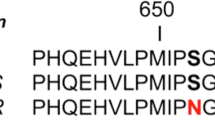Abstract
Templeman and Sexton1 were the first to show that ethyl and isopropyl phenylcarbamates were selectively toxic to higher plants and therefore potentially valuable as herbicides. Since then, Ennis2, Ivens and Blackman3 and Doxey4 have reported on the mitotic effects induced by these compounds. It has generally been assumed that their action is primarily on the spindle of dividing cells; but a continuation of the work at Oxford suggests that other factors may be involved.
This is a preview of subscription content, access via your institution
Access options
Subscribe to this journal
Receive 51 print issues and online access
$199.00 per year
only $3.90 per issue
Buy this article
- Purchase on Springer Link
- Instant access to full article PDF
Prices may be subject to local taxes which are calculated during checkout
Similar content being viewed by others
References
Templeman, W. G., and Sexton, W. A., Nature, 156, 630 (1946).
Ennis, W. B., Amer. J. Bat., 35, 18 (1948).
Ivens, G. W., and Blackman, G. E., Symp. Soc. Exp. Biol., 3, 266 (1949).
Doxey, D., Ann. Bot., 13, 329 (1949).
Levan, A., and Östergren, G., Hereditas, 29, 381 (1943).
Östergren, G., Hereditas, 30, 429 (1944).
Author information
Authors and Affiliations
Rights and permissions
About this article
Cite this article
IVENS, G., BLACKMAN, G. Inhibition of Growth of Apical Meristems by Ethyl Phenylcarbamate. Nature 166, 954–955 (1950). https://doi.org/10.1038/166954b0
Issue Date:
DOI: https://doi.org/10.1038/166954b0
This article is cited by
-
Effects of ethylN-phenylcarbamate on wall microtubules and on gibberellin- and kinetin-controlled cell expansion
The Botanical Magazine Tokyo (1977)
Comments
By submitting a comment you agree to abide by our Terms and Community Guidelines. If you find something abusive or that does not comply with our terms or guidelines please flag it as inappropriate.



